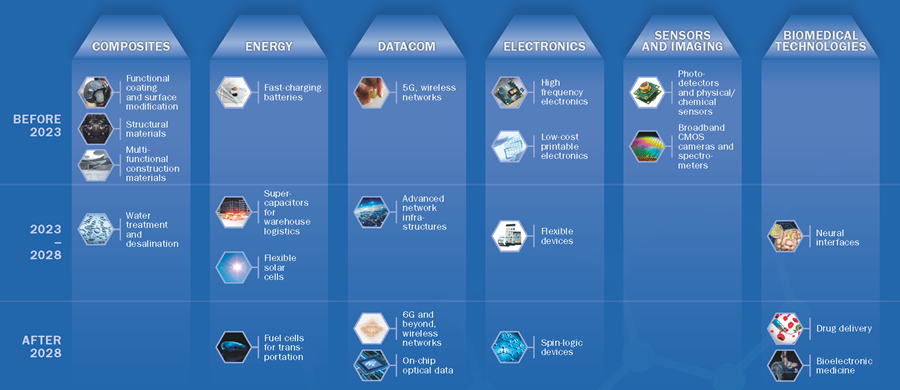Mapping Graphene’s Industry Potential
The Graphene Flagship’s Technology and Innovation Roadmap demonstrates the various paths that graphene can take to transition from the lab to use in industrial applications.
The Graphene Flagship’s Technology and Innovation Roadmap (TIR) demonstrates the various paths that graphene can take to transition from the lab to use in industrial applications. The roadmap aggregates a common view on graphene and related materials (GRM) and provides guidance for graphene research towards market demands. It establishes a timeline for when one can expect graphene to be applied to different application areas.
In every focus investigation, the insufficient maturity of the graphene industry was identified as a major challenge to the commercialisation of graphene-based products. Beyond the expansion of production capacity and simultaneous price reductions, key factors for the commercialisation of GRMs include regulatory hurdles, a lack of standardisation and technical demands to graphene properties often only defined in the specific application context.
Through a series of workshops, the Graphene Flagship’s industrialisation team worked to identify specific markets in which graphene could fill a niche or was uniquely suited to solve an industry problem. The latest version of the TIR specifically explored four promising areas for graphene commercialization: supercapacitors, anti-corrosion, Li-ion batteries and neural interfaces.
“Each individual focus investigation explores specific potential future value chains down to exemplary end products such as forklifts, off-shore wind power or hearing aids,” says Henning Döscher of the Graphene Flagship industrialisation group. “The idea is both promoting information exchange across the specific industrial innovation interfaces and deducing exemplary, in-depth information on drivers and obstacles for GRM commercialization.”
“We learn that some aspects may be unique for a very specific niche, others may be at least similar among several application areas, and some issues occur over and over again. Expanding to new focus investigation topics, we hope to both explore further exciting highlight application areas of graphene and, in the sum of the distinct examples, eventually, to obtain a more in-depth understanding of the diverse graphene applications and to foster their impact on European industries. Hence, we intensified our efforts to involve stakeholder inputs from both industry and the Graphene Flagship to identify and select meaningful topics that promise high specific impact and complement our perspective on the entire field,” he adds.
The industrialisation group’s work over the first five years of the Graphene Flagship identified unmet industrial needs in several sectors, such as energy, automotive and logistics, where GRM could offer solutions in the medium or long run.
“For instance, the logistics industry does not only strive for advanced forklifts (with better suited energy supply systems), but also for novel warehouse systems based on automated guided vehicles (AGV) for which the energy supply demands may shift dramatically,” notes Thomas Reiss, deputy leader for the Graphene Flagship industrialisation group. “However, most of the industrial experts involved in any of our workshops were not aware of the needs and offers of the other stakeholder groups positioned down or up the value chain compared to their own. Hence, there is an urgent need for introducing and elaborating this value chain perspective for different application scenarios. That is exactly what we will intensify in the forthcoming roadmapping work.”
In elaborating the current roadmap, the team discovered significant scepticism towards industrial graphene utilization. The common denominator in industry anecdotes, either from active experience or passive observation, was a lack of quality standards. Therefore, further focus on the Graphene Flagship’s standardization efforts will be key to graphene’s success in the marketplace.
“The lack of application-oriented and traceable material quality standards appears to be the single most important barrier for graphene industrialization across all application fields,” Döscher says.
“The interaction between Graphene Flagship partners and the TIR group has worked very well in the past, and we strongly encourage keeping it up and extending it in the future,” Reiss says. Project members can access the group’s results on the Flagship’s intranet and are encouraged to continue to support and participate in future TIR activities.





